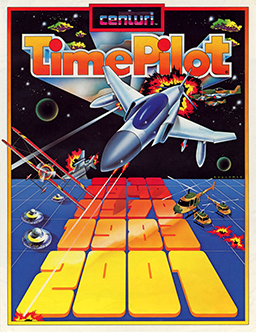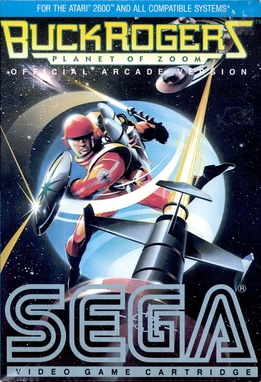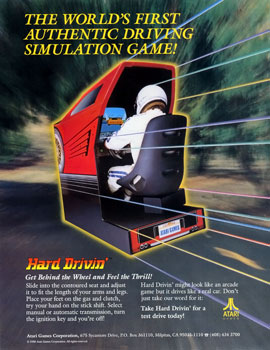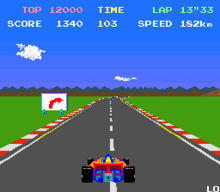
Zaxxon is a scrolling shooter developed and released by Sega as an arcade video game in 1982. The player pilots a ship through heavily defended space fortresses. Japanese electronics company Ikegami Tsushinki was also involved in the game's development.
Racing games are a video game genre in which the player participates in a racing competition. They may be based on anything from real-world racing leagues to fantastical settings. They are distributed along a spectrum between more realistic racing simulations and more fantastical arcade-style racing games. Kart racing games emerged in the 1990s as a popular sub-genre of the latter. Racing games may also fall under the category of sports video games.

Final Lap is a 1987 racing simulation video game developed and published by Namco. Atari Games published the game in the United States in 1988. It was the first game to run on Namco's then-new System 2 hardware and is a direct successor to Namco's Pole Position (1982) and Pole Position II (1983). It was ported to the Famicom by Arc System Works, making it Arc System Works' debut game.

Ms. Pac-Man is a 1982 maze arcade video game developed by General Computer Corporation and published by Midway. It is the first sequel to Pac-Man (1980) and the first entry in the series to not be made by Namco. Controlling the title character, Pac-Man's wife, the player is tasked with eating all of the pellets in an enclosed maze while avoiding four colored ghosts. Eating the larger "power pellets" lets the player eat the ghosts, who turn blue and flee.
1983 has seen many sequels and prequels in video games, such as Mario Bros. and Pole Position II, along with new titles such as Astron Belt, Champion Baseball, Dragon's Lair, Elevator Action, Spy Hunter and Track & Field. Major events include the video game crash of 1983 in North America, and the third generation of video game consoles beginning with the launch of Nintendo's Family Computer (Famicom) and Sega's SG-1000 in Japan. The year's highest-grossing video game was Namco's arcade game Pole Position, while the year's best-selling home system was Nintendo's Game & Watch for the third time since 1980.

Track & Field, also known as Hyper Olympic in Japan and Europe, is an Olympic-themed sports video game developed by Konami and released as an arcade video game in 1983. The Japanese release sported an official license for the 1984 Summer Olympics. In Europe, the game was initially released under the Japanese title Hyper Olympic in 1983, before re-releasing under the US title Track & Field in early 1984.

Time Pilot is a multidirectional shooter arcade video game designed by Yoshiki Okamoto and released by Konami in 1982. It was distributed in the United States by Centuri, and by Atari Ireland in Europe and the Middle East. While engaging in aerial combat, the player-controlled jet flies across open airspace that scrolls indefinitely in all directions. Each level is themed to a different time period. Home ports for the Atari 2600, MSX, and ColecoVision were released in 1983.

Buck Rogers: Planet of Zoom, known as Zoom 909 in Japan, is a pseudo-3D rail shooter released as an arcade video game by Sega in 1982. The player controls a spaceship in a third-person perspective, adapting the three-dimensional perspective of Sega's earlier racing game Turbo (1981) for the space shoot 'em up genre. It uses the Buck Rogers license, referencing the space battles, though Buck himself is never seen.

Night Driver is an arcade video game developed by Atari, Inc. and released in the United States in October 1976. It's one of the earliest first-person racing video games and is commonly believed to be one of the first published video games to feature real-time first-person graphics. Night Driver has a black and white display with the hood of the player's car painted on a plastic overlay. The road is rendered as scaled rectangles representing "pylons" that line the edges.

Virtua Racing or V.R. for short, is a Formula One racing video game developed by Sega AM2 and released for arcades in 1992. Virtua Racing was initially a proof-of-concept application for exercising a new 3D graphics platform under development, the "Model 1". The results were so encouraging that Virtua Racing was fully developed into a standalone arcade title.
1985 saw many sequels and prequels in video games, such as Super Mario Bros. and Kung Fu, along with new titles such as Commando, Duck Hunt, Gauntlet, Ghosts 'n Goblins, Gradius, Hang-On, Space Harrier, Tetris and The Way of the Exploding Fist. The year's highest-grossing arcade video games were Hang-On and Karate Champ in the United States, and Commando in the United Kingdom. The year's best‑selling home system was the Nintendo Entertainment System (Famicom) for the second year in a row, while the year's best‑selling home video game was Super Mario Bros.
1984 saw many sequels and prequels along with new titles such as 1942, Boulder Dash, Cobra Command, Jet Set Willy, Karate Champ, Kung-Fu Master, Yie Ar Kung-Fu and Punch-Out!! The year's highest-grossing arcade games were Pole Position in the United States, for the second year in a row, and Track & Field in the United Kingdom. The year's best-selling home system was Nintendo's Family Computer (Famicom), which was only sold in Japan at the time.
1982 was the peak year for the golden age of arcade video games as well as the second generation of video game consoles. Many games were released that would spawn franchises, or at least sequels, including Dig Dug, Pole Position, Mr. Do!, Zaxxon, Q*bert, Time Pilot and Pitfall! The year's highest-grossing video game was Namco's arcade game Pac-Man, for the third year in a row, while the year's best-selling home system was the Atari 2600. Additional video game consoles added to a crowded market, notably the ColecoVision and Atari 5200. Troubles at Atari late in the year triggered the video game crash of 1983.
1979 saw many sequels and prequels in video games, such as Space Invaders Part II and Super Speed Race, along with new titles such as Asteroids, Football, Galaxian, Head On, Heiankyo Alien, Monaco GP, Sheriff and Warrior. For the second year in a row, the highest-grossing video game was Taito's arcade game Space Invaders and the best-selling home system was the Atari Video Computer System.

Mr. Do! is a 1982 maze video game developed by Universal. It is the first arcade video game to be released as a conversion kit for other cabinets; Taito published the conversion kit in Japan. The game was inspired by Namco's Dig Dug released earlier in 1982. Mr. Do! was a commercial success in Japan and North America, selling 30,000 arcade units in the US, and it was followed by several arcade sequels.

TX-1 is an arcade racing simulation game developed by Tatsumi and released in 1983. It was licensed to Namco, who in turn licensed it to Atari, Inc. for release in the United States, thus the game is considered a successor to Pole Position and Pole Position II. It was also released in the United Kingdom, Ireland and mainland Europe via Atari Ireland.

Pole Position II is the sequel to racing simulation game Pole Position, released by Namco for arcades in 1983. As with its predecessor, Namco licensed this game to Atari, Inc. for US manufacture and distribution. Atari Corporation released a port as the pack-in game for its Atari 7800 ProSystem console launch in 1986. Pole Position arcade machines can be converted to Pole Position II by swapping several chips.

Hard Drivin' is a sim racing arcade video game developed by Atari Games in 1989. Players test drive a sports car on courses that emphasize stunts and speed. It features one of the first 3D polygon driving environments via a simulator cabinet with a haptic vibrating steering wheel and a custom rendering architecture.

F-1 is a 1976 electro-mechanical arcade racing game developed and published by Nakamura Manufacturing Company (Namco), and distributed in North America by Atari, Inc. The player uses a steering wheel to control a Formula One racer, which must avoid collision with other vehicles. The game uses a miniature diorama with small, plastic cars to represent the player's car and opponents on a physical, rotating track, while also featuring a projector system and lighting tricks to create the illusion of racing.

Speed Race is a 1974 arcade racing video game developed and manufactured by Taito and released under the titles Racer and Wheels in North America by distributor Midway Manufacturing in 1975. Designed by Tomohiro Nishikado, the gameplay involves the player using the attached steering wheel to maneuver a car alongside a fast vertical scrolling road. The objective is to score points by driving past other cars without colliding with them; more points are awarded for driving faster. Players must do this under a 90-second time limit, which ends the game when it runs out. The gameplay concepts were adapted from two earlier driving electro-mechanical games: Kasco's Mini Drive (1958) and Taito's Super Road 7 (1970).
















